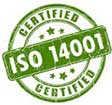Zinc Die Casting: High Precision and Excellent Properties.
Zinc is one of the most versatile die cast metals. It provides higher precision with lower tooling costs when compared to other die cast metals like aluminum or magnesium. Zinc die casting also offers a broad range of excellent physical and mechanical properties, finishing characteristics, and is the easiest to cast.
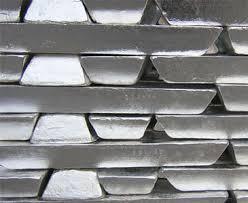
Advantages of Using Zinc
One of the most significant advantages of zinc is the fact that it reduces tooling costs. Die cast tooling is typically a significant cost factor, so it’s important to save where you can. Because zinc has a low melting temperature, dies can last up to 10 times longer than those used in aluminum die casting and about five times longer than dies used for magnesium. That means fewer repairs, less downtime, and more parts produced over the life of the tool. Small zinc parts can utilize the high-speed 4-slide miniature zinc die casting process, which allows for significantly lower upfront tooling costs when compared to aluminum or magnesium. Click here to learn more about that process.
The advantages of zinc die casting include:
- Longer tool life
- Lower tooling cost (particularly if it can use the miniature zinc die casting process)
- The ability to cast near net-shaped complex geometries with thinner walls and less draft angle than castings produced with other metals reduces the need for machine features.
- Excellent balance of mechanical and physical properties, including higher yield strength and elongation when compared to aluminum or magnesium.
- Good vibration dampening capacity compared to aluminum
- Wide range of finishing options
- Faster production time
The many advantages of zinc allow it to be used in a wide range of industries and applications.
The Zinc Die Casting Process
Zinc is cast with the fast-cycling hot chamber die casting process, which utilizes a component called a gooseneck that is submerged in a furnace filled with molten metal. Metal automatically enters the shot chamber through a hole in the gooseneck. A vertical plunger then seals the hole and drives the metal into the back of the die with high pressure. The part rapidly solidifies (within seconds), and the part is ejected from the tool.
Zinc Alloys Available at CWM
CWM casts two different zinc alloys: Zamak No. 3 and ZA-8. Both offer the ability to cast with intricate detail and close dimensional tolerances at high production rates.
Zamak 3 is the most commonly used zinc alloy in die casting, mainly because it offers superior castability and excellent finishing characteristics. Zamak #3’s elongation properties allow it to be crimped or swaged to other components.
ZA-8 is often the choice when additional strength and greater creep resistance are required.
With various machine sizes ranging up to 500 tons of locking force, CWM can produce zinc parts from miniature to over 20” long.
You can visit our request a quote page or contact Chicago White Metal here to review your project with a die cast engineer.
Zinc Alloys Available at CWM
CWM casts two different zinc alloys: Zamak No. 3 and ZA-8. Both offer the ability to cast with intricate detail and close dimensional tolerances at high production rates.
Zamak 3 is the most commonly used zinc alloy in die casting, mainly because it offers superior castability and excellent finishing characteristics. Zamak #3’s elongation properties allow it to be crimped or swaged to other components.

ZA-8 is often the choice when additional strength and greater creep resistance are required.
With various machine sizes ranging up to 500 tons of locking force, CWM can produce zinc parts from miniature to over 20” long.
You can visit our request a quote page or contact Chicago White Metal here to review your project with a die cast engineer.
Learn More About Zinc Die Casting:
This overview for OEM designers and specifiers is a refresher for those OEM product design engineers, buyers, and purchasing managers already familiar with die casting. For those new to the process, it provides a valuable framework or further pursuit. View the PDF: The Die Casting Process: An OEM Designer’s Overview |
Presents the facts on why multi-slide, miniature zinc die casting is the preferred choice for small precision components. It enables product designers to learn how this specialized die casting process can substantially reduce component costs and provide optimal precision to a new project design or a conversion from an existing process. |
6-page guide outlines ten key cost drivers that design engineers can leverage during the product design stage to yield significant cost savings in the custom production of die cast components. These specific planning steps aid in integrating the realities of die cast manufacturing. View the PDF: 10 Ways to Reduce the Costs of Die Cast Parts |
2-page descriptive detailed data sheet for Chicago White Metal Casting’s current high-tech production specifications, material properties, and nominal chemistry for its Al, Mg & Zn alloy capabilities. View the PDF: CWM Al, Mg & Zn Die Cast Production Specs |
Overview of Chicago White Metal Casting miniature 4-slide Zn 3, 5 & ZA-8 die cast part capabilities, with CWM specifications, alloy characteristics. CWM specializes in delivering miniature parts with any required post-casting finishing, ready for further assembly, including precision machining when net-shapes are not possible. View the PDF: CWM Miniature Die Casting Capabilities Profile, Specifications, Alloy Data |
Updated and expanded 16-page reference to the initial design & specification steps that drive the cost and performance of components die cast in Al, Mg, and Zn alloys. Among essential design and production factors covered: Matching material properties; Die design & construction; Minimizing part porosity; Optimizing part heat transfer; Preplanning post-casting machining, if required; Dimensioning and tolerancing; Flash considerations; Prototyping; and as-cast finish guidelines. View the PDF: Design & Specification Guide for Custom Die Castings |
Computer workstations from Silicon Graphics incorporated a zinc die cast rear cap frame, which combined important structural function with superior cosmetic appearance. The Zn die cast component, selected for its excellent strength, rigidity, EMI shielding characteristics, and part consolidation potential, was the first use by the company of a die casting in one of their workstation computers. View the PDF: Die Cast Zn for Key Computer Structural Component |
A value analysis of alternate production efficiencies for a low-volume CNC machined brass small component for a medical device resulted in a miniature zinc net-shape die cast replacement at a 500% unit cost saving. View the PDF: Replacement for Machined Brass at a 500% Savings |
Detailed overview of the contents of the 176-page Product Design for Die Casting manual on optimizing designs for die casting. View the PDF: NADCA Design Manual: Intro & Content |
This chart compares the material, and physical properties for three popular die casting alloys: aluminum A380, magnesium AZ91D, Zinc #3, and ZA8. Several material properties such as tensile strength, impact, and yield strength can be compared between the three alloys. Physical properties, such as density and conductivity, can also be examined. View the PDF: Material / Physical Properties Comparison |
Updated Zn and ZA alloy selection, machining and finishing data; chemical composition; material properties and die casting and other characteristics. View the PDF: NADCA Standards: Zinc & ZA Alloy Data |
Condensed overview for OEM product designers and engineers on Miniature Zinc & ZA-8 custom die casting for the cost-effective production of small, complex structural components. View the PDF: Primer on Miniature Zinc & ZA-8 Die Casting |
Guide to developing optimum prototyping strategies for developing and testing component designs before final die casting die construction. This guide discusses prototyping alloys and processes, including new rapid prototyping technologies. View the PDF: Prototyping for Die Casting in All Alloys |
8-page condensed resource on evaluating finishing alternatives and optimizing component finishing decisions for Al, Mg, and Zn die cast products. Features a comparison table rating 32 surface coatings on relative cost, appearance, wear, and corrosion resistance; Presents recommended finishing for a range of typical die cast components. View the PDF: Quick Guide to Surface Finishing for Al, Mg & Zn Parts |
Brief overview of surface treatment systems for die cast part protection, decoration, and improving component performance, for all alloys: Al, Mg, Zn, and ZA. View the PDF: Surface Finishing for Die Casting Bulletin |
Presentation to aid efficiency, functionality, and cost savings in the design and production of custom die castings. This narrated Webinar focuses on helping effectively capitalize on today’s advanced die casting capabilities to improve performance and lower the costs of their custom components. 1 hour. |
Presents the important factors that can affect the outcome of the final appearance of your die cast component when its surface finish is a critical issue. This narrated Webinar will aid an understanding of the various finish options and how their uses and limitations can make the difference between successful product development and costly results. 49 minutes. |
When production runs for a machined part increase, advanced net-shape die casting can offer substantial unit cost savings compared to part machining to specifications. Such cost reductions are being achieved for a wide variety of machined part applications in a range of alloys and part sizes. In the case of many small precision parts, the net-shape 4-slide miniature die casting process can be used to replace a brass machined part at no sacrifice in mechanical properties for significant savings at even low production volumes. This Tech Brief discusses the many advantages of machining-to-die casting conversions in addition to unit cost savings. View the PDF: Converting Machined Parts to Die Casting |
Condensed overview for OEM product designers and engineers on Miniature Zinc & ZA-8 custom die casting for the cost-effective production of small, complex structural components. View the PDF: Primer on Miniature Zinc & ZA-8 Die Casting |
Presents the facts on why multi-slide, miniature zinc die casting is the preferred choice for small precision components. It enables product designers to learn how this specialized die casting process can substantially reduce component costs and provide optimal precision to a new project design or a conversion from an existing process. |
Overview of Chicago White Metal Casting miniature 4-slide Zn 3, 5 & ZA-8 die cast part capabilities, with CWM specifications, alloy characteristics. CWM specializes in delivering miniature parts with any required post-casting finishing, ready for further assembly, including precision machining when net-shapes are not possible. View the PDF: CWM Miniature Die Casting Capabilities Profile, Specifications, Alloy Data |
A value analysis of alternate production efficiencies for a low-volume CNC machined brass small component for a medical device resulted in a miniature zinc net-shape die cast replacement at a 500% unit cost saving. View the PDF: Replacement for Machined Brass at a 500% Savings |
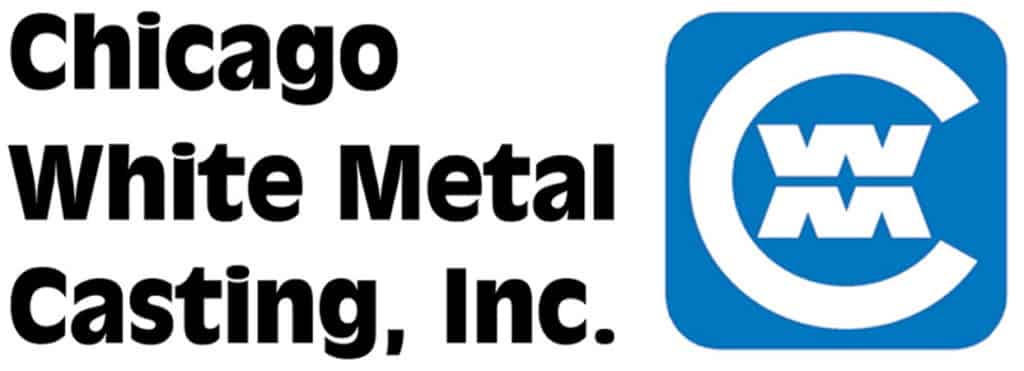
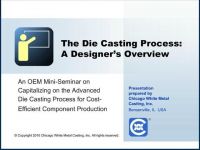 The Die Casting Process: An OEM Designer’s Overview
The Die Casting Process: An OEM Designer’s Overview The Miniature Zinc Die Casting Advantage
The Miniature Zinc Die Casting Advantage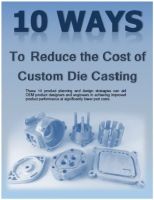 10 Ways to Reduce the Costs of Die Cast Parts
10 Ways to Reduce the Costs of Die Cast Parts CWM Al, Mg & Zn Die Cast Production Specs
CWM Al, Mg & Zn Die Cast Production Specs  CWM Miniature Die Casting Capabilities Profile, Specifications, Alloy Data
CWM Miniature Die Casting Capabilities Profile, Specifications, Alloy Data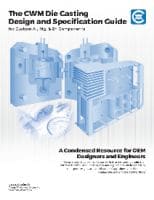 Design & Specification Guide for Custom Die Castings
Design & Specification Guide for Custom Die Castings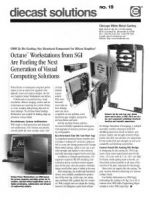 Die Cast Zn for Key Computer Structural Component
Die Cast Zn for Key Computer Structural Component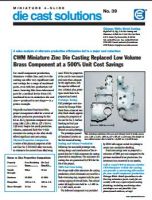 Replacement for Machined Brass at a 500% Savings
Replacement for Machined Brass at a 500% Savings NADCA Design Manual: Intro & Content
NADCA Design Manual: Intro & Content Material / Physical Properties Comparison
Material / Physical Properties Comparison NADCA Standards: Zinc & ZA Alloy Data
NADCA Standards: Zinc & ZA Alloy Data Primer on Miniature Zinc & ZA-8 Die Casting
Primer on Miniature Zinc & ZA-8 Die Casting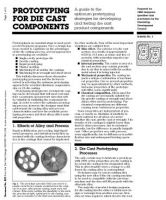 Prototyping for Die Casting in All Alloys
Prototyping for Die Casting in All Alloys Quick Guide to Surface Finishing for Al, Mg & Zn Parts
Quick Guide to Surface Finishing for Al, Mg & Zn Parts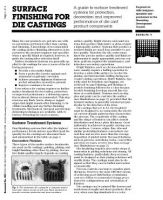 Surface Finishing for Die Casting Bulletin
Surface Finishing for Die Casting Bulletin Product Solutions Through Die Casting
Product Solutions Through Die Casting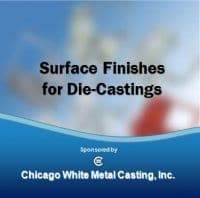 Surface Finishes for Die Casting
Surface Finishes for Die Casting Converting Machined Parts to Die Casting
Converting Machined Parts to Die Casting Primer on Miniature Zinc & ZA-8 Die Casting
Primer on Miniature Zinc & ZA-8 Die Casting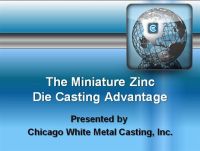 The Miniature Zinc Die Casting Advantage
The Miniature Zinc Die Casting Advantage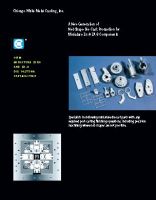 CWM Miniature Die Casting Capabilities Profile, Specifications, Alloy Data
CWM Miniature Die Casting Capabilities Profile, Specifications, Alloy Data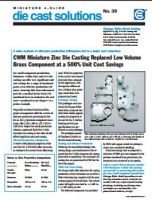 Replacement for Machined Brass at a 500% Savings
Replacement for Machined Brass at a 500% Savings

